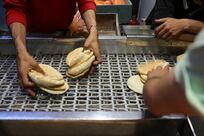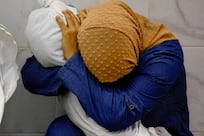Rolla Square is a roundabout dominated by a massive green-and-white statue, commemorating an even larger tree that once stood at its centre.
Located a few steps from the coast, near Sharjah's Heritage Area, it is hidden by blocks of unimpressive buildings. Their bottom floors are cluttered with small stores, restaurants and businesses catering mostly to those with low incomes; some clothing and electronics sell for as little as Dh20.
Ali al Shamsi, 65, stood recently before the statue of a tree - an unusual sight anywhere in the world, let alone the Arabian Peninsula, as he tried to explain how it came to be there.
"Here stood the biggest and greatest tree of the UAE," Mr al Shamsi said.
He grew up in the Rolla neighbourhood, long before it transformed into Al Ghuwair market area. There used to be a single school, a few traditional homes, a store or two and a continuous flow of nomads and caravans who sought shelter from the beating sun.
"It was a common sight to see travelling families stopping by here to rest under the Rolla tree," he said.
Every day after school, Mr al Shamsi and his classmates would meet at the "special spot" before they headed home. "The tree was huge," he said. "There were swings on its branches, which we all fought over, and we would climb it and have fun, and see the world from its top.
"All of us, including the animals, like cats and camels, would sit under it and enjoy its shade."
The statue is half the size of the original Rolla, or Banyan tree, which is believed to have covered at least 30 metres with its outstretched branches, and to have stood more than 15 metres high. With its thick, complex root system and heavy cover, it stood out from the rest of the smaller desert trees.
It is said to have been the first Banyan tree to be planted in the UAE, transported from India by ship in the early 1800s by the then-Ruler of Sharjah, Sheikh Sultan bin Saqr Al Qasimi.
It became the centre of gatherings from across the UAE for special occasions including Eid, national day celebrations and weddings. The grand tree lasted in its new home in the UAE for more than 150 years before it finally "fell" in 1978.
"We saw it slowly die with the onset of construction of roads around it," said Mohammed al Ali, 72. "One day, it just gave up and fell."
Shortly after, Dr Sheikh Sultan bin Mohammed, the Ruler of Sharjah, had the statue built.
The square was open to the public until six months ago, with mainly labourers enjoying the shade of the smaller Banyan trees that were planted around the statue. It is under renovation, with plans to turn the area into a family park. Just steps away is Al Sharq Hotel, which opened in 1996 using the tree's image as its theme and trademark, "so people don't forget the history of the place," said Sanjeeb Kumar, the hotel's front-office manager.
An oil painting of the tree in the hotel lobby depicts a gathering of Emirati men and children underneath the shady branches. The men came with their falcons, and several are perched on portable resting stands under the tree.
"The photo from which this painting was made was falling apart, so the owners of the hotel recreated it in the form of a painting for future generations to enjoy," said Mr Kumar, who has been working at the hotel since its opening.
Other people in the area also appreciate the tree's legend. "The Banyan tree is a magical and mystical tree in India, and so we feel at home living and working in a place where our trees are loved," said Reny Matthew, 30, one of the employees at the Joyalukkas centre across from the square.
"The Rolla square is a landmark for our community, and a landmark for the nationals."






